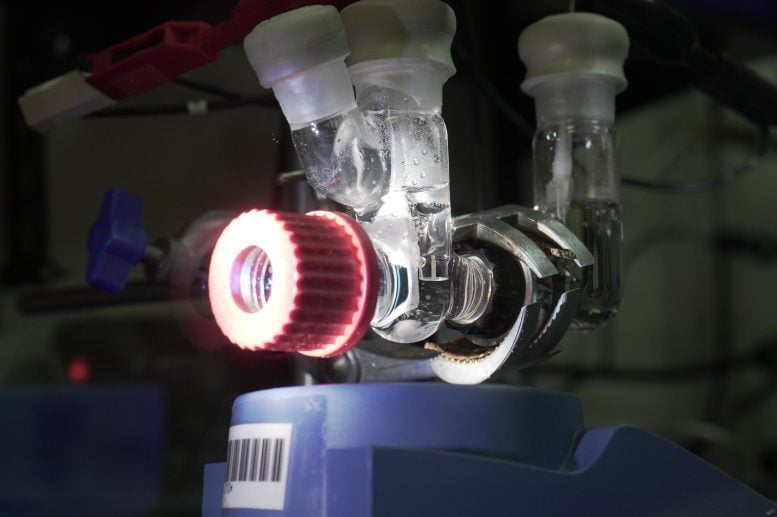**Sustainable Chemistry Breakthrough: Semi-Artificial Leaf Powers Green Chemical Production**
*University of Cambridge | November 4, 2025 | by Red Badger*
—
A team of scientists led by the University of Cambridge has developed a groundbreaking “semi-artificial leaf” that can run continuously and efficiently to produce pharmaceutical compounds with high purity. This non-toxic system promises to replace fossil fuels in chemical manufacturing and usher in a new era of sustainable green chemistry.
### Revolutionizing the Chemical Industry
The global chemical industry is responsible for around 6% of global carbon emissions due to its reliance on fossil fuels to transform raw materials into products ranging from plastics and cosmetics to pharmaceuticals and fertilizers. Recognizing the urgent need to reduce this sector’s environmental impact, researchers are pioneering innovative techniques to “de-fossilize” chemical production.
### What Is the Semi-Artificial Leaf?
The newly developed device is a hybrid system combining light-absorbing organic polymers with bacterial enzymes. It mimics photosynthesis by using sunlight, water, and carbon dioxide to produce formate — a clean fuel that can power other chemical reactions. Unlike previous artificial photosynthesis models, this biohybrid leaf operates efficiently without external power sources, toxic materials, or unstable additives.
Importantly, the system integrates *organic semiconductors* as the light-harvesting component — a first in this field — making the device safer, more durable, and environmentally friendly. The research was published in the journal *Joule* on October 10, 2025.
### Advantages Over Earlier Designs
Professor Erwin Reisner, who leads the research from Cambridge’s Yusuf Hamied Department of Chemistry, explains:
“If we’re going to build a circular, sustainable economy, the chemical industry is a big, complex problem we must address. This new organic biohybrid system offers a huge opportunity to produce necessary chemicals without fossil fuels.”
Many previous artificial leaves relied on synthetic catalysts or inorganic semiconductors that degrade quickly, waste significant sunlight, or contain toxic elements like lead. This new approach removes such toxic components, delivering a clean chemical reaction with a single, high-purity product and no unwanted side reactions.
Co-first author Dr. Celine Yeung adds:
“Organic semiconductors are tunable and non-toxic, while biocatalysts are highly selective and efficient. Our device combines the best of both worlds.”
### Overcoming Enzyme Stability Challenges
Sustaining enzyme function typically requires chemical additives called buffers, which degrade quickly and reduce system stability. The team overcame this by embedding the helper enzyme *carbonic anhydrase* into a porous titania structure, allowing the semi-artificial leaf to operate stably in a simple bicarbonate solution similar to sparkling water—eliminating the need for unsustainable additives.
“It’s like solving a big puzzle,” said co-first author Dr. Yongpeng Liu. “Understanding how to immobilize specific enzymes on electrodes enabled us to design the different layers of our sandwich-like device effectively.”
### Record Efficiency and Durability
Testing demonstrated the leaf produces high currents and achieves near-perfect efficiency in directing electrons toward fuel-making reactions. Remarkably, the device ran continuously for over 24 hours—more than twice the duration of previous designs.
The team aims to extend the device’s lifespan further and adapt it to produce a wider variety of chemical products.
Reisner reflects:
“We’ve shown it’s possible to create solar-powered devices that are efficient, durable, and free from toxic or unsustainable components. This could become a fundamental platform for producing green fuels and chemicals in the future—a real opportunity to do exciting, important chemistry.”
—
### Research Reference
*Yeung, C. W. S., Liu, Y., Vahey, D. M., Cobb, S. J., Andrei, V., Coito, A. M., Manuel, R. R., Pereira, I. A. C., & Reisner, E. (2025). Semi-artificial leaf interfacing organic semiconductors and enzymes for solar chemical synthesis. Joule. https://doi.org/10.1016/j.joule.2025.102165*
—
### Funding and Acknowledgements
The research was supported by the Singapore Agency for Science, Technology and Research (A*STAR), the European Research Council, the Swiss National Science Foundation, the Royal Academy of Engineering, and UK Research and Innovation (UKRI).
Professor Erwin Reisner is a Fellow of St John’s College, Cambridge, and Dr. Celine Yeung is a member of Downing College, Cambridge.
—
*For more updates on sustainable chemistry and green technology innovations, follow [Scitech Daily].*
—
*Disclaimer: Opinions expressed are those of the authors or individual contributors and do not necessarily represent the views of Scitech Daily or its affiliates.*
https://freerepublic.com/focus/f-chat/4350613/posts

